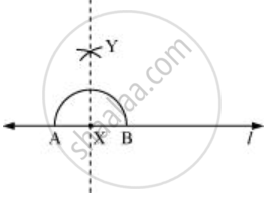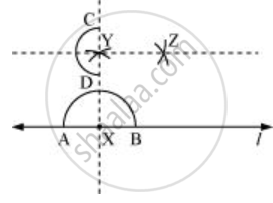Advertisements
Advertisements
Question
Draw a line l and point X on it. Through X, draw a line segment `overline"XY"` perpendicular to l.
Now draw a perpendicular `overline"XY"` to at Y. (use ruler and compasses)
Solution
- Draw a line l and mark a point X on it.

- Taking X as centre and with a convenient radius, draw an arc intersecting line l at two points A and B.

- With A and B as centres and a radius more than AX, construct two arcs intersecting each other at Y.

- Join XY. `overline"XY"` is perpendicular to l.

Similarly, a perpendicular to `overline"XY"` at the point Y can be drawn. The line is perpendicular to `overline"XY"` at Y.
APPEARS IN
RELATED QUESTIONS
Draw line l. Take any point P on the line. Using a set square, draw a line perpendicular to line l at the point P.
Draw a line AB. Using a compass, draw a line perpendicular to AB at the point B.
Draw line CD. Take any point M on the line. Using a protractor, draw a line perpendicular to line CD at the point M.
Take a point R on line XY. Draw a line perpendicular to XY at R, using a set square.
Draw a line segment AB = 7 cm and mark a point P on it. Draw a line perpendicular to the given line segment at P
Number of set squares in the geometry box is ______.
The common properties in the two set-squares of a geometry box are that they have a ______ angle and they are of the shape of a ______.
Two perpendiculars can be drawn to a given line from a point not lying on it.
Using only the two set-squares of the geometry box, an angle of 40° can be drawn.
Using only the two set-squares of the geometry box, an angle of 15° can be drawn.
